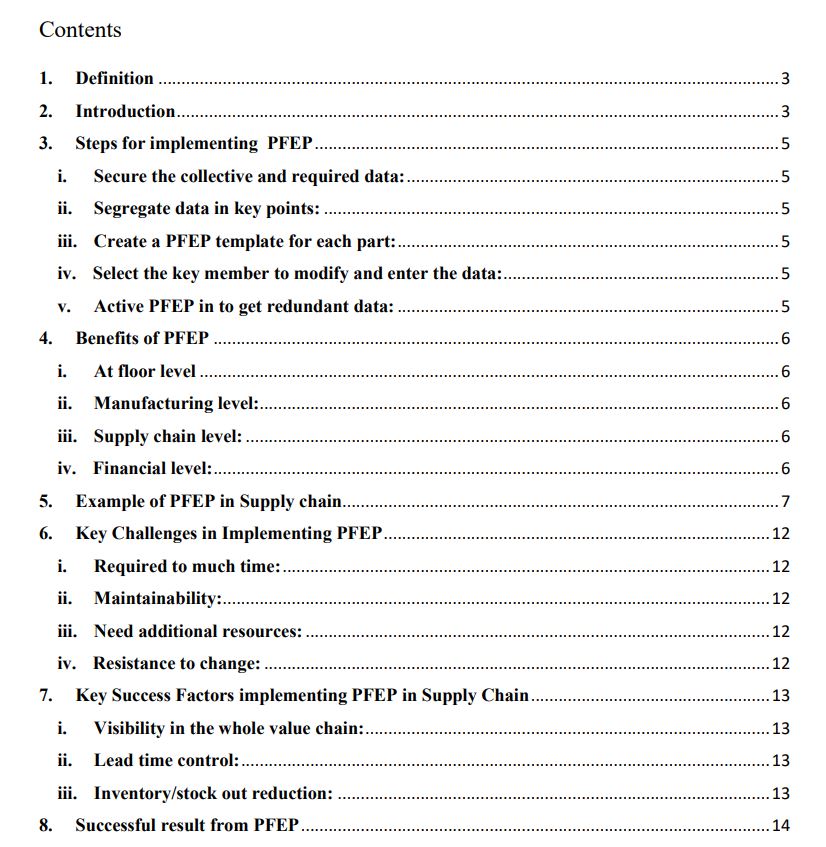Plan for Every Part Template (PFEP Guide)
This Plan for Every Part template (PFEP template) and guide helps supply chain professionals map, organize, and manage critical data across the value chain. It covers modeling, suppliers, logistics, demand, warehouses, process planning, factory material handlers, floor workers, quality teams, and customer data — showing how every part is connected. What Is a Plan for

1.4 MB
61 Readers
Unlimited access, anywhere, anytime
Upgrade to Student or Pro plan to avail more discounts and perks
Table of Contents
- Definition 3
- Introduction3
- Steps for implementing PFEP5
- Secure the collective and require data 5
- Segregate data in key points5
- Create PFEP Templet for each part5
- Select the key member to modify and enter the data5
- Active PFEP in to get redundant data5
- Benefits of PFEP6
- At floor level6
- Manufacturing level6
- Supply chain level6
- Financial level6
- Example of PFEP in Supply chain7
- Key Challenges in Implementing PFEP12
- Required to much time12
- Saistanity and maintainability12
- Need additional resources12
- Resistance to change12
- Key Success Factors implementing PFEP in Supply Chain13
- Visibility in the whole value chain13
- Lead time control13
- Inventory/stock out reduction13
- Successful result from PFEP14
This Plan for Every Part template (PFEP template) and guide helps supply chain professionals map, organize, and manage critical data across the value chain. It covers modeling, suppliers, logistics, demand, warehouses, process planning, factory material handlers, floor workers, quality teams, and customer data — showing how every part is connected.
What Is a Plan for Every Part (PFEP)?
A Plan for Every Part (PFEP template) can be thought of as a ten-times bigger version of a Material Resource Planning (MRP) system. Unlike MRP, PFEP includes more data points, generating detailed product information and making it available to the right person or location at the right time.
The concept originates from the Lean manufacturing community. PFEP defines, at the part level, the most efficient replenishment method and tracks the movement of every part through the entire supply chain.
Why Use a PFEP Template?
During my years as a Manufacturing Plant Supply Chain Manager, using a Plan for Every Part template delivered significant benefits, including:
-
Identifying the right planning policy (based on your stocktaking procedure)
-
Level-loading production plans for improved efficiency
-
Better on-time delivery and lower inventory levels — two critical supply chain KPIs
For a more detailed explanation, see: What is Plan for Every Part (PFEP)? – 4 Levels of Benefits.
What This Plan for Every Part Template Guide Includes
This practical PFEP guide helps you:
-
Understand PFEP concepts step by step
-
Learn how to implement a PFEP template in real operations
-
Explore benefits and challenges of implementation
-
Review practical examples and case studies
Table of Contents – PFEP Template Guide
[caption id="attachment_13168" align="alignleft" width="826"] Table of contents showing key sections included in the Plan for Every Part template guide[/caption]
Table of contents showing key sections included in the Plan for Every Part template guide[/caption]
Download the Plan for Every Part Template
You can download the complete Plan for Every Part template. Each PFEP template can contain data unique to a specific part, but when combined, the set of templates provides full visibility into all materials across the supply chain.
Remember: every part matters, even if it costs just one cent or is ordered once a year.
[caption id="attachment_13155" align="alignleft" width="1786"] Snapshot of the Plan for Every Part (PFEP) template showing how part-level data is organized[/caption]
Snapshot of the Plan for Every Part (PFEP) template showing how part-level data is organized[/caption]
Related Resources
We also recommend watching:
-
5 Levels of Supply Chain Planning (YouTube) — showing where PFEP fits into the overall planning hierarchy.


